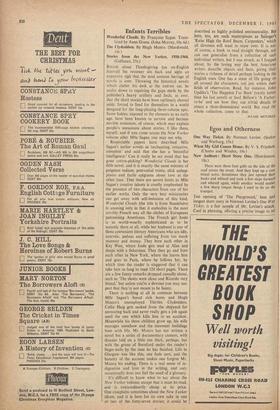Enfants Terribles
Wonderful Clouds. By Frangoise Sagan. Trans-
I 6s.)
Stories from the New Yorker, 1950-1960. (Ciollancz, 25s.)
ROUND about Thanksgiving (an Un-English
festival) the reviewer sits back and sighs an expansive sigh that the mad autumn barrage of novels is over. Throwing the historical novels which clutter his desk at the nearest cat, he settles down to repairing the gaps made by the publisher's heavy artillery and finds, as ever, that the short stories have been ruthlessly shoved aside, forced to fend for themselves in a world designed for the long-playing three-volume epic.
Some babies, exposed to the elements at an early age. have been known to survive and become
terrible nuisances, of course, which may explain people's uneasiness about stories. I like them, myself, and if you come across the New Yorker volume after Mlle Sagan you may see why.
Respectable papers have described Mlle Sagan's earlier novels as 'enchanting, evocative, complete' and said that she has a 'beautiful intelligence.' Can it really be my mind that has gone cotton-picking? Wonderful Clouds is her fifth novel, and it is exactly the same mixture of
poignant tedium, post-coital tristia, slick unhap- piness and facile epigrams about love as the
other four. That there are severe limits to Mlle Sagan's creative talents is cruelly emphasised by the presence of two characters from one of her earlier works. Only the very best miniaturists
can get away with self-imitation of this kind. Wonderful Clouds (the title is from Baudelaire)
is amusing only in that it embodies in the most terribly French way all the clichés of Europeans patronising Americans. The French girl Josee is so world-wearily sophisticated as to be scarcely there at all, while her husband is one of those convenient literary Americans who are idle, neurotic, jealous and suffering from too much mummy and money. They bore each other in Key West, where Josee gets mad at Alan and sleeps with a fisherman. They then go and bore each other in New York, where she leaves him and goes to Paris, where he follows her, by which time the reader is staggered that it can take him so long to read 124 short pages. There are a few funny remarks dropped casually about, such as 'The sheets were clean and Ricardo very brutal,' but unless you're a devotee you may sus- pect that they're not meant to be funny.
There is nothing at all in common between Mlle Sagan's bored rich bores and Hugh Munro 's unemployed Thirties Clydesiders. Collie Haig gets sacked from the shipyard for answering back and never really gets a job again until the one which kills him in an accident. Meanwhile his three children grow up, his wife manages somehow and the tenement buildings hum with life. Mr. Munro has not written a novel but a series of documentary cameos, with disaster laid on a little too thick, perhaps, but with the grime of Burnford under the reader's finger-nails by the time he has finished. Life in Glasgow was like this, one feels sure, and the honesty of the account makes one forgive Mr. Munro his ending. There is a real sense of in- dignation and love in the writing, and only occasionally does one feel the need of a glossary.
It's difficult to know what to say about the New Yorker volume, except that it must be read, and is extraordinarily cheap at its price. One complains sometimes about the New Yorker idiom, and it is here for its own sake in one -.or two of the forty-seven stories; it could be described as highly polished sentimentality. But here, too, are such masterpieces as Salinger's 'Raise High the Roof Beam, Carpenters,' which all devotees will want to muse over. It is not, of course, a book to read straight through, nor can one generalise from a collection of such individual writers, but I was struck, as I hopped about, by the loving way the best American writers describe objects and facts, giving their ' stories a richness of detail perhaps lacking in the English ones. One has a sense of life going on all around the characters, not just within their fields of observation. Read, for instance, John Updike's 'The Happiest I've Been' (vastly better than his last novel) or Saul Bellow's 'A Father- to-be' and see how they use trivial details to create a three-dimensional world. But read the whole collection, come to that.
JULIAN MITCHELL






































 Previous page
Previous page